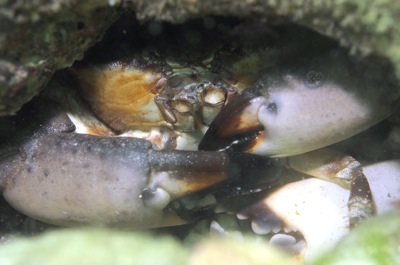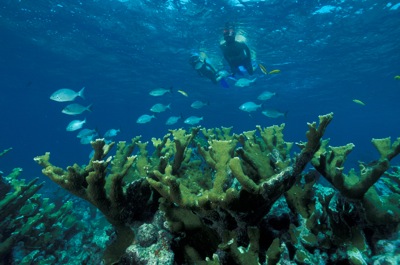
When in season, stone crabs in demand
HOMESTEAD, Fla. — For most Floridians, mid-October signifies the approaching end of the dreaded hurricane season.
But for the state’s fishermen, it marks the beginning of their busy season as they embark on eight months of catching one of the state’s most popular delicacies: stone crabs.
Weeks before the tables of local crab shacks become filled with hungry customers, bodies of water across the state become filled with fishermen and their boats.
Each year, on Oct. 15, commercial and recreational crabbers alike drop their traps for the first of many times in the eight-month season. In South Florida, the waters of Biscayne National Park are no exception.
| Stone crabbing season begins each year on Oct. 15 and ends on May 15 for both recreational and commercial fishermen. This past 2010-11 season nearly three million pounds of stone crabs were produced (Photo courtesy of Don Demaria). |  |
“We get around half a dozen commercial boats regularly on the waters… and, in addition, divers and fishers with traps,” said Evan Pickford, a law enforcement ranger at Biscayne National Park.
Though Pickford acknowledged the park itself has never attempted to determine the number of stone crabs in its waters, it can be assumed there is no shortage surrounding the state. Florida Fish and Wildlife Conservation Commission estimated nearly three million pounds of stone crab claws were produced during the 2010-11 harvest.
Last season was also financially successful for fishermen.
Amanda Nalley, public information officer for the Florida Fish and Wildlife Conservation Commission, reported the wholesale value of last season’s take was “about $25 million, up almost $5.6 million from 2009-10.”
The large amount of money generated from stone crabs each year isn’t only from commercial fishermen. According to Nalley, a significant number of stone crabs caught each year are for recreational purposes. While the end product is the same, the rules vary between those who fish commercially and those fishing as a recreation.
Recreational crabbers can begin their season the same day as commercial crabbers, but are not allowed to set more than five traps at a time. They can also only gather up to one gallon of claws. In contrast, commercial fishermen can set an unlimited number of traps.
 |
Divers at Biscayne National Park. In addition to using traps, some stone crabs are taken by divers (Photo courtesy of Biscayne National Park). |
Whether working for recreational purposes or planning to sell the crabs commercially, Nalley explained there are some rules every crabber must abide by. Stone crabs must be caught during daylight hours and not taken in navigational waters. All traps must indicate personal identification. In both cases, specific certification for crabbing is required through the Florida Fish and Wildlife Conservation Commission.
The number of these certificates for trapping is high, but they are getting harder to come by.
“Currently, there are more than one million certificates out there,” Nalley explained. “A new crabber must purchase these from others who already have them. FFWCC no longer gives them out.”
In recent years, FFWCC has begun to retire some traps only furthering the barriers to stone crabbing for prospective commercial fishermen.
When it comes to crab protection, all fishermen, commercial and recreational alike, are held to the same standard. According to Nalley, it is unlawful to use any device for the taking of stone crabs that can puncture, crush or injure the crab body, such as spears, grains, grabs, hooks or similar devices.
One common misconception involving the harvesting of stone crabs is the assumption that fishermen must only remove one, but not both, claws.
“Many people believe you can only take one, but that isn’t true. It is better though for the stone crab if only one claw is harvested because that leaves them with a claw to eat and defend themselves with.” Nalley explained. “The more they can eat, the faster their missing claw will grow back. It takes about three years for a regenerated claw to reach the harvestable size.”
The average life span for a stone crab remains seven years for males and eight years for females.
The rationale behind not eating the entire stone crab is simple: there is very little meat found on the crab’s actual body and by only breaking off the claw and releasing the crab alive, it has the potential to re-grow its claw and be caught again.
In order to help enforce fishing regulations and offer clarification to these rules, Biscayne National Park offers a free, once-a-month, fisheries awareness class.
“Some people go to learn more about fishing at our park, but the majority of the people who attend are those issued fines for violating state fishing regulations,” said Pickford.
Similar to traffic school, individuals who received fishing citations may, at the discretion of ticketing law enforcement agent, take the course in order to have fines reduced or even waived. Overall, the class covers the importance of fishing regulations, how to interpret these rules, how to identify one’s catch, how to properly catch and release and offers new tips and techniques.
In addition, park officers are continually working to address stone crab issues, particularly one of their biggest concerns: trap theft.
“Trap robbing is a big concern for commercial fishermen as it causes loss in total annual harvest and profit,” said Katie Purcell, law enforcement spokesperson for the Florida Fish and Wildlife Conservation Commission. “The Department of Law Enforcement has been setting up special details to target those people that knowingly molest traps, as they are stealing from the State of Florida and all of the legal commercial and recreational harvesters.”
By working at night, during the day in highly trafficked fishing areas, and additionally, working in civilian clothing, officers hope to stop these thefts from continuing.
Through greater education and stronger law enforcement, park services hope to further improve commercialization while continue preserving the conservation of stone crabs.
If You Go:
Obtaining a recreational fishing license:
A Florida saltwater recreational fishing license is required to harvest stone crabs under the recreational fishing regulations. These can cost anywhere from a $17 one year saltwater only license to a $301.50 lifetime saltwater fishing license. A popular choice is the $32.50 saltwater and freshwater combination license. It lasts a year and is for Florida residents only. Visit http://myfwc.com/license/recreational/saltwater-fishing/ for a chart of costs including out of state.
Equipment regulations:
- There are two main methods available to catch a stone crab dinner: you can put out your own traps or dive for them.
- According to Florida law, any angler may use up to five stone crab traps.
- Recreational traps must meet the following criteria:
- Buoys must have a legible “R” at least two inches high, permanently affixed to them.
- Traps must have the harvester’s name and address affixed to them in legible letter and must be retrieved manually (no motorized trap pullers, those are for commercial use only)
- Traps must not be placed in navigational channels or waterways.
- Each trap must have a degradable wooden panel equal to the size of the entry hole on the top of the trap.
- Plastic and wire traps already rigged can be found at most bait and tackle shops.
When to fish:
- Stone crab fishing season lasts from October 15th – May 15th for both recreational and commercial fishermen.
- Retrieving traps and diving may only occur during daylight hours.
Removing stone crab claw:
- Claws must be a minimum length of 2 3/4-inches (removed at elbow or first joint and measured from tip of moving part of claw to joint)
Biscayne National Park Fisheries Awareness Class
- Meets once per month, with odd-numbered month classes offered in English and even-numbered month classes offered in Spanish.
- Date that class meets varies each month. To see schedule of upcoming classes please visit: http://www.nps.gov/bisc/planyourvisit/fisheries-awareness-class.htm
- Wednesday courses: 6 p.m. – 9:30 p.m.
- Saturday courses: 9 a.m. – 12:20 p.m.
- The course is offered at two different locations (specified by date): Suniland Park, Pinecrest, 12855 S. Dixie Hwy., Miami, Fla. 33156; and Biscayne National Park, Discovery Room, on the lower level of the Visitor Center, 9700 SW 328th St., Homestead, Fla. 33033.
- For more information of to enroll, please contact Cristalis Capielo, Fisheries Education Program Coordinator, 305-230-1144 ext. 036.

Comments are Closed